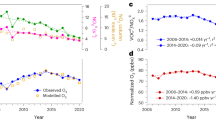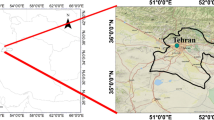Abstract
Sanya has geographical and climatic characteristics such as low latitude, high temperature, high salt, high humidity, and strong solar radiation all year round, which is conducive to the occurrence of photochemical reactions; therefore, the problem of ozone photochemical pollution in Sanya needs to be solved urgently. This article is based on the hourly data of O3 and NO2 in Sanya City in 2019, various collected meteorological data, and online monitoring of VOCS major species data to analyze the characteristics of ozone pollution changes and source apportionment in Sanya City. The results indicate that the daily variation characteristics of ozone pollution in Sanya City conform to the typical characteristics of ozone photochemical pollution events, and the EKMA curve indicates that Sanya City as a whole belongs to a NOX-sensitive area. The OH consumption rate (LOH) and ozone generation potential (OFP) indicate that the key active components of VOCS are mainly isoprene, ethylene, n-butane, propane, etc. The corresponding main potential sources of emissions include combustion emissions, solvent volatilization, and automotive exhaust emissions. The O3 emission reduction plan is to reduce the ozone concentration from 180 to 158 µg·m−3, corresponding to a 25 and 20% reduction in the concentrations of the two main precursors, NOX and VOCS, respectively. This article provides scientific support for the problem of ozone photochemical pollution in Sanya City.




Similar content being viewed by others
Data Availability
All the authors confirm that the data supporting the funding of this study are available within the article and its supplementary materials. Also, data can be obtained from the authors on a reasonable request.
References
Cao XC, Wu XC, Xu WS et al (2021) Characteristics of atmospheric VOCs pollution, ozone generation potential, and source apportionment in Sanya City. Environ Sci Res 34(08):1812–1824
Cao JJ (2014) PM2.5 and environment. Science Press, Beijing
Cao ZL (2022) Study on the characteristics of concentration changes of ozone and its precursors in Xi’an high tech zone. Xi’an university of architecture and technology
Chen TC, Pan WB (2019) statistical analysis of Chinese literature on EKMA model. Environ Sci Manag 44(12):10–14
Cui M, An XQ, Sun ZB et al (2020) Simulation of ozone generation and precursor sensitivity in Beijing. In: Proceedings of the 20th annual conference of the Chinese society of environmental sciences on science and technology (Volume 1) Chinese academic journal (CD version), published by Electronic Magazine Co.Ltd.19
Ding BH, Lai LF (2019) The impact of different precursor reduction ratios on ozone in Zhuhai City. Environ Sci J 38(S1):51–53
Ding A, Wang T, Zhao M et al (2004) Simulation of sea-land breezes and a discussion of their implications on the transport of air pollution during a multi-day ozone episode in the Pearl river delta of China. Atmos Environ 38(39):6737–6750
Fu CB (2021) Characteristics and meteorological causes of ozone pollution in cities of Hainan province. Meteorological Publishing House, Beijing
Hao WH, Wang WY, Zhang YC et al (2018) Sensitivity analysis and development of control strategies for ozone generation in Chengdu. J Environ Sci 38(10):3894–3899. https://doi.org/10.13671/j.hjkxxb.2018.0200
He L (2018) Research on the characteristics and sources of atmospheric volatile organic compounds pollution in Chengdu Urban area. Southwest Jiaotong University
Huang QM (2022) Study on ozone sensitivity of eighteen prefectural cities in Henan province. Zhengzhou University
Kinosian JR (1982) Ozone-precursor relationships from EKMA diagrams. Environ Sci Technol 16(12):880–883
Li YY, Zhu B, An JL et al (2013) Observation and study on autumn VOCS and its photochemical characteristics in the northern suburbs of Nanjing. Environ Sci 34(08):2933–2942
Li LY, Xie SD, Zeng LM et al (2015) Characteristics of volatile organic compounds and their role in ground-level ozone formation in the Beijing–Tianjin–Hebei region, China. Atmos Environ 113:247–254
Li MQ (2015) Study on the pollution characteristics and chemical reactivity of volatile organic compounds in the air of Xi’an urban area. Xi’an University of Architecture and Technology
Li ZK (2016) Research on nonlinear response characteristics and control strategies of ozone and its precursors in the Pearl river delta. South China University of Technology
Manahan SE (1999) Environmental chemistry. Lewis publishers, UK
Ministry of ecology and environment of the people's republic of China (2018) Letter on soliciting opinions on the technical guidelines for source apportionment of environmental air ozone pollution [Trial] [draft for soliciting opinions]
Ozone pollution control professional committee of the Chinese society of environmental sciences (2020) Blue book on prevention and control of atmospheric ozone pollution in China (2020). Science Press, Beijing, pp 40–43
Ren JY, Zhu KG, Xie M et al (2021) Analysis of atmospheric ozone sensitivity and pollution sources in Xianning city. China Environ Sci 41(09):4060–4068
Sanya ecological environment bureau (2022) Announcement of Sanya ecological environment bureau on the environmental status of Sanya city in 2019[EB/OL] [2022–3–2].
Zhang LL (2016) Characteristics and source analysis of atmospheric volatile organic compounds in Qingpu district. Wuhan University of Technology, Shanghai
Zhang YN (2017) Research on ozone pollution control in Tianjin. Tianjin University of Technology
Zhao M (2023) A study on the characteristics and generation mechanism of ozone pollution in typical delta cities. Shandong University
Acknowledgements
This research was supported by the “National Natural Science Foundation of China” (Grant No. 42267015) and the Education Department of Hainan Province (Grant No. Hnjg2021-78).
Author information
Authors and Affiliations
Corresponding authors
Ethics declarations
Conflict of interest
This manuscript has not been published or presented elsewhere in part or in entirety and is not under consideration by another journal. All the authors have approved the manuscript and agree with submission to your esteemed journal. There are no conflicts of interest to declare.
Rights and permissions
Springer Nature or its licensor (e.g. a society or other partner) holds exclusive rights to this article under a publishing agreement with the author(s) or other rightsholder(s); author self-archiving of the accepted manuscript version of this article is solely governed by the terms of such publishing agreement and applicable law.
About this article
Cite this article
Huang, D., Wang, P., Lu, F. et al. Change Characteristics and Source Apportionment of Ozone Pollution in Sanya City in 2019. Aerosol Sci Eng (2024). https://doi.org/10.1007/s41810-024-00218-8
Received:
Revised:
Accepted:
Published:
DOI: https://doi.org/10.1007/s41810-024-00218-8




